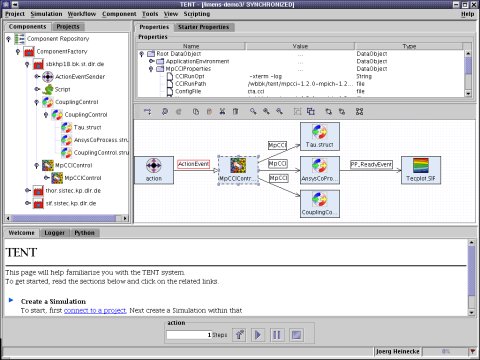Provenance
Start of topic | Skip to actions
TENT
The Simulation Integration Environment TENT
 TENT is a software integration and workflow management system that simplifies work by means of simulation process chains in distributed environments. In TENT all tools of a simulation can be integrated and centrally started and run from a user's desktop via a graphical user interface (GUI).
The major characteristics of TENT are:
TENT is a software integration and workflow management system that simplifies work by means of simulation process chains in distributed environments. In TENT all tools of a simulation can be integrated and centrally started and run from a user's desktop via a graphical user interface (GUI).
The major characteristics of TENT are:
- Use of distributed computing resources (PCs, workstations, clusters or supercomputers with scheduling systems, and Computational Grids)
- Visual presentation of workflows on a graphical user interface (GUI) available on all systems
- Flexibility in setup, configuration, online control and online visualization of simulations
- Integration of project-based data management including the option of collaborative work
- Monitoring and control of an ongoing simulation from any computer
- Simple integration of existing applications
- Automatic, high-performance data exchange between all the steps of a distributed simulation workflow
The Project SikMa
 The DLR project SikMa (Simulation of Complex Manoeuvres) is under the direction of the Institute of Aerodynamics and Flow Technology (AS). The objective is to develop an interactive simulation environment for the simulation of a freely flying, fully configured, elastic warplane. To implement the simulation, the aerodynamic, flight mechanical and aeroelastic equation systems will be calculated at every step, for a time-accurate coupling of aerodynamics, flight mechanics and aeroelasticity.
The DLR project SikMa (Simulation of Complex Manoeuvres) is under the direction of the Institute of Aerodynamics and Flow Technology (AS). The objective is to develop an interactive simulation environment for the simulation of a freely flying, fully configured, elastic warplane. To implement the simulation, the aerodynamic, flight mechanical and aeroelastic equation systems will be calculated at every step, for a time-accurate coupling of aerodynamics, flight mechanics and aeroelasticity.
 In addition, the results from the SikMa project will drive the idea of TENT, a uniform simulation environment for the DLR, and make a substantial contribution to the DLR core area of the virtual aircraft. Along with the development of the interactive integration environment and the computing processes and coupling algorithms, the SikMa project will also do wind-tunnel testing with different models in different manoeuvre scenarios, in order to obtain a comprehensive data set for the verification and validation of the overall simulation environment.
In addition, the results from the SikMa project will drive the idea of TENT, a uniform simulation environment for the DLR, and make a substantial contribution to the DLR core area of the virtual aircraft. Along with the development of the interactive integration environment and the computing processes and coupling algorithms, the SikMa project will also do wind-tunnel testing with different models in different manoeuvre scenarios, in order to obtain a comprehensive data set for the verification and validation of the overall simulation environment.
Provenance Data
The following gives an overview of the provenance information to be recorded within the workflows of the simulation integration environment TENT:Interaction (and Input) Provenance
 Between system components records for process documentation, the ability for process restarts, the tracking of user access to data, and user access control are generated. In case of a computational job being rejected by a utilized batch system or Grid the provenance system has to recognize this and notify TENT for re-submission of the job. Workflow control information and data interchange between system components as well as input files for both - CFD and aero-elastic codes - need to be identified and recorded.
Between system components records for process documentation, the ability for process restarts, the tracking of user access to data, and user access control are generated. In case of a computational job being rejected by a utilized batch system or Grid the provenance system has to recognize this and notify TENT for re-submission of the job. Workflow control information and data interchange between system components as well as input files for both - CFD and aero-elastic codes - need to be identified and recorded.
Actor Provenance
For reasons of reproducibility version information on used algorithms and computational codes have got to be tracked along with the data itself. -- GuyKKloss - 11 May 2005to top
| I | Attachment  | Action | Size | Date | Who | Comment |
|---|---|---|---|---|---|---|
| | manouver.jpg | manage | 9.1 K | 11 May 2005 - 16:08 | GuyKKloss | |
| | tentIntegration.jpg | manage | 10.3 K | 11 May 2005 - 16:09 | GuyKKloss | |
| | tentIntegration_sm.png | manage | 30.0 K | 11 May 2005 - 16:09 | GuyKKloss | |
| | tentScreenie.jpg | manage | 38.8 K | 11 May 2005 - 16:10 | GuyKKloss | |
| | x31.jpg | manage | 9.7 K | 11 May 2005 - 16:11 | GuyKKloss | |
| | x31flow.jpg | manage | 17.6 K | 11 May 2005 - 16:11 | GuyKKloss |
Edit | Attach image or document | Printable version | Raw text | More topic actions
Revisions: | r1.4 | > | r1.3 | > | r1.2 | Total page history | Backlinks
Revisions: | r1.4 | > | r1.3 | > | r1.2 | Total page history | Backlinks
Provenance.AerospaceEngineering moved from Restricted.PublicProvenanceApplication1 on 16 May 2005 - 07:19 by LucMoreau - put it back